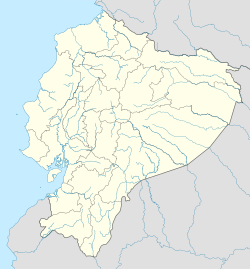Cayambe Kayampi | |
|---|---|
City | |
 Calle 23 de Julio | |
| Motto: It is my passion (Es mi Pasion) | |
| Coordinates: 0°02′38″N78°09′22″W / 0.04389°N 78.15611°W | |
| County | Ecuador |
| Province | Pichincha |
| Canton | Cayambe |
| Legal creation | July 23, 1883 |
| Urban parishes | List |
| Government | |
| • Mayor | Alberto Masapanta (2023-2027) |
| • Vice Mayor | Ana María Lema Valencia |
| Area | |
• City | 11.71 km2 (4.52 sq mi) |
| Elevation | 2,830 m (9,280 ft) |
| Population (Census 2022-10-01) [1] | |
• City | 44,559 |
| • Density | 3,800/km2 (9,900/sq mi) |
| Time zone | UTC-5 (ECT) |
| Climate | 14° Csb |
Cayambe is an agricultural service city (population 44,559 at the last census on October 1, 2022) in highland Ecuador. It lies at the foot of the Cayambe volcano. While the city is mainly peopled by mestizos, the surrounding rural population is primarily composed of indigenous people who are mainly involved in subsistence agriculture, dairy farming and procurement of lumber. It is the third-largest city in Pichincha Province.





